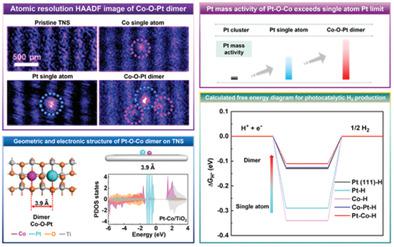当前位置:
X-MOL 学术
›
Adv. Mater.
›
论文详情
Our official English website, www.x-mol.net, welcomes your
feedback! (Note: you will need to create a separate account there.)
Co and Pt Dual‐Single‐Atoms with Oxygen‐Coordinated Co–O–Pt Dimer Sites for Ultrahigh Photocatalytic Hydrogen Evolution Efficiency
Advanced Materials ( IF 27.4 ) Pub Date : 2021-02-22 , DOI: 10.1002/adma.202003327 Cong Wang 1 , Kaiwen Wang 1 , Yibo Feng 1 , Chong Li 2 , Xiaoyuan Zhou 3, 4 , Liyong Gan 3, 4 , Yajie Feng 3, 4 , Hanjun Zhou 3, 4 , Bin Zhang 3, 4 , Xianlin Qu 1 , Hui Li 1 , Jieyuan Li 5 , Ang Li 1 , Yiyang Sun 6 , Shengbai Zhang 7 , Guo Yang 1 , Yizhong Guo 1 , Shize Yang 8 , Tianhua Zhou 9 , Fan Dong 5 , Kun Zheng 1 , Lihua Wang 1 , Jun Huang 1 , Ze Zhang 1, 10 , Xiaodong Han 1
Advanced Materials ( IF 27.4 ) Pub Date : 2021-02-22 , DOI: 10.1002/adma.202003327 Cong Wang 1 , Kaiwen Wang 1 , Yibo Feng 1 , Chong Li 2 , Xiaoyuan Zhou 3, 4 , Liyong Gan 3, 4 , Yajie Feng 3, 4 , Hanjun Zhou 3, 4 , Bin Zhang 3, 4 , Xianlin Qu 1 , Hui Li 1 , Jieyuan Li 5 , Ang Li 1 , Yiyang Sun 6 , Shengbai Zhang 7 , Guo Yang 1 , Yizhong Guo 1 , Shize Yang 8 , Tianhua Zhou 9 , Fan Dong 5 , Kun Zheng 1 , Lihua Wang 1 , Jun Huang 1 , Ze Zhang 1, 10 , Xiaodong Han 1
Affiliation

|
The platinum single‐atom‐catalyst is verified as a very successful route to approach the size limit of Pt catalysts, while how to further improve the catalytic efficiency of Pt is a fundamental scientific question and is challenging because the size issue of Pt is approached at the ultimate ceiling as single atoms. Here, a new route for further improving Pt catalytic efficiency by cobalt (Co) and Pt dual‐single‐atoms on titanium dioxide (TiO2) surfaces, which contains a fraction of nonbonding oxygen‐coordinated Co–O–Pt dimers, is reported. These Co–Pt dimer sites originate from loading high‐density Pt single‐atoms and Co single‐atoms, with them anchoring randomly on the TiO2 substrate. This dual‐single‐atom catalyst yields 13.4% dimer sites and exhibits an ultrahigh and stable photocatalytic activity with a rate of 43.467 mmol g−1 h−1 and external quantum efficiency of ≈83.4% at 365 nm. This activity far exceeds those of equal amounts of Pt single‐atom and typical Pt clustered catalysts by 1.92 and 1.64 times, respectively. The enhancement mechanism relies on the oxygen‐coordinated Co–O–Pt dimer coupling, which can mutually optimize the electronic states of both Pt and Co sites to weaken H* binding. Namely, the “mute” Co single‐atom is activated by Pt single‐atom and the activity of the Pt atom is further enhanced through the dimer interaction. This strategy of nonbonding interactive dimer sites and the oxygen‐mediated catalytic mechanisms provide emerging rich opportunities for greatly improving the catalytic efficiency and developing novel catalysts with creating new electronic states.
中文翻译:

Co和Pt双原子与氧配位的Co-O-Pt二聚体位点,可实现超高的光催化氢释放效率
事实证明,铂单原子催化剂是一种接近Pt催化剂尺寸极限的非常成功的途径,而如何进一步提高Pt的催化效率是一个基本的科学问题,并且因为在Pt的尺寸问题上已经达到了一个挑战,因此具有挑战性。最终的上限是单个原子。在这里,报道了一种通过二氧化钛(TiO 2)表面上的钴(Co)和Pt双单原子进一步提高Pt催化效率的新途径,其中包含一小部分非键合氧配位的Co-O-Pt二聚体。这些Co–Pt二聚体位点源自装载高密度Pt单原子和Co单原子,它们随机锚固在TiO 2上基质。这种双单原子催化剂可产生13.4%的二聚体位点,并以43.467 mmol g -1 h -1的速率表现出超高且稳定的光催化活性。在365 nm处的外部量子效率约为83.4%。该活性远远超过等量的Pt单原子催化剂和典型的Pt簇状催化剂分别1.92倍和1.64倍。增强机制依赖于氧配位的Co-O-Pt二聚体耦合,可以相互优化Pt和Co位点的电子态以减弱H *结合。即,“静音”的Co单原子被Pt单原子激活,并且Pt原子的活性通过二聚体相互作用进一步增强。这种非键合的相互作用的二聚体位点的策略和氧介导的催化机制为新兴的丰富机会提供了极大的机会,可以极大地提高催化效率和开发新的电子状态并开发新的催化剂。
更新日期:2021-04-01
中文翻译:

Co和Pt双原子与氧配位的Co-O-Pt二聚体位点,可实现超高的光催化氢释放效率
事实证明,铂单原子催化剂是一种接近Pt催化剂尺寸极限的非常成功的途径,而如何进一步提高Pt的催化效率是一个基本的科学问题,并且因为在Pt的尺寸问题上已经达到了一个挑战,因此具有挑战性。最终的上限是单个原子。在这里,报道了一种通过二氧化钛(TiO 2)表面上的钴(Co)和Pt双单原子进一步提高Pt催化效率的新途径,其中包含一小部分非键合氧配位的Co-O-Pt二聚体。这些Co–Pt二聚体位点源自装载高密度Pt单原子和Co单原子,它们随机锚固在TiO 2上基质。这种双单原子催化剂可产生13.4%的二聚体位点,并以43.467 mmol g -1 h -1的速率表现出超高且稳定的光催化活性。在365 nm处的外部量子效率约为83.4%。该活性远远超过等量的Pt单原子催化剂和典型的Pt簇状催化剂分别1.92倍和1.64倍。增强机制依赖于氧配位的Co-O-Pt二聚体耦合,可以相互优化Pt和Co位点的电子态以减弱H *结合。即,“静音”的Co单原子被Pt单原子激活,并且Pt原子的活性通过二聚体相互作用进一步增强。这种非键合的相互作用的二聚体位点的策略和氧介导的催化机制为新兴的丰富机会提供了极大的机会,可以极大地提高催化效率和开发新的电子状态并开发新的催化剂。











































 京公网安备 11010802027423号
京公网安备 11010802027423号